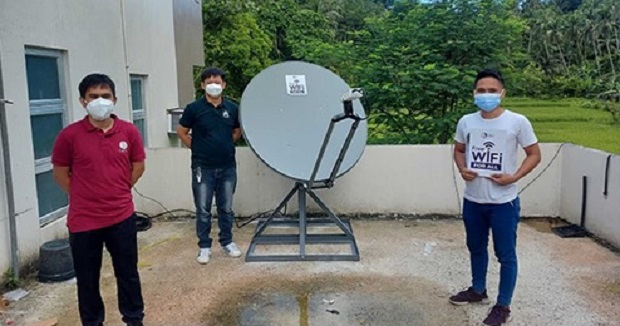Former Department of Information and Communications Technology (DICT) undersecretary Eliseo Rio Jr. refuted on Tuesday, June 1, the statement of the DICT claiming that Very Small Aperture Terminal (VSAT) technology provides cheaper and faster Internet to remote areas of the country.
Rio, who has become the harshest critic of the ICT agency, made a Facebook post on the same day that the DICT said the VSAT solutions that it deployed in geographically isolated and disadvantaged areas (GIDAs) are “20 times faster at five-times lower costs” compared to the previous iteration of the similar initiative done through a partnership between the DICT and the United Nations Development Program (UNDP).
The DICT was referring to the “Pipol Konek” Project which the UNDP awarded to Australian network firm by Speedcast International Limited (SLI). The project has been cancelled by the DICT and is now asking the UNDP and Speedcast to return the money so it can take over the rollout of the Wi-Fi project.
But, Rio said that VSAT is “definitely” not the answer for better, faster and cheaper access to the Internet. “Saying that one VSAT system is 20 times faster than another, but 5 times less expensive is something that cannot be supported by facts,” he wrote.
“A faster speed VSAT system will definitely cost more than a slower speed VSAT, there is no way to go around this because it is the law of physics that has to be followed here. Anyone who claims that a faster VSAT can be cheaper than a slower VSAT is either a magician or does not know the natural laws of physics that govern this phenomenon,” he said.
Rio said a fiber-optic cable link will make Internet connection faster and cheaper than any VSAT system using natural laws of physics. “That is why VSATs are cost-effective only in places where there are absolutely no cables or any terrestrial means to bring in internet connectivity,” he pointed out.
He said the DICT was “ill-advised in believing” that its VSAT project was way better than the UNDP project when they both follow the same technology and laws of physics.
“In fact, the DICT-UNDP project has the advantage of economy of scale having 5,000 installations versus only 1,035 for the MIS-VSAT project. And all 5,000 VSATs are located in unserved areas where some areas are off-grid and are powered by solar panels. Many of the 1,035 MIS VSATs are in areas already reached by optic cables,” he said.
Rio said the misguided “thinking” of the DICT has allowed it to put VSATs in areas already reached by optic cables and other terrestrial means. “That is a total waste of people’s money. This does not speak well of DICT that is suppose[d] to be in the forefront in improving ICT services for our people,” he said.
In its statement, the DICT explained that while the deployment of free Wi-Fi sites in GIDAs resembles the UNDP “Pipol Konek” Project as they both install sites in remote areas using similar technologies, there are significant differentiators between the two deployments’ speeds and prices.
The DICT said the VSAT technology that it deployed has a combined CIR (committed information rate) of 6.3 megabits per second (Mbps) with three access points per site, while the UNDP-deployed VSAT has a combined (download plus upload) CIR of 0.3 Mbps for one access point per site only.
“Overall, DICT’s VSATs provides about 20 times faster minimum speeds than the UNDP VSATs. With respect to the maximum Internet speeds, the DICT VSAT has a MIR of 25 Mbps, while a UNDP VSAT site has a MIR (maximum information rate) of 2 Mbps,” it said.
With respect to price, the DICT said the UNDP’s price per access point for its Phase 1 project is around P19,148 while DICT’s is at P30,000 per access point. However, on a price per Mbps basis, the DICT said it VSAT costs only P 14,285.71 per month per Mbps, compared to UNDP’s which costs P63,826.67 per month per Mbps.
“In annual terms, a UNDP VSAT equates to P765,920.00 per Mbps per year, while a DICT VSAT is at P171,428.57. Thus, the price of DICT VSATs is around five times cheaper than a UNDP VSAT. DICT’s cost for the contracted 6.3 Mbps CIR per year is at P1,080,000. If a UNDP VSAT were to theoretically reach those speeds at the same cost per Mbps, the cost per year would be P4,825,296,” the agency said.
The DICT insisted that its VSAT services “are not only cheaper on a per Mbps computation but provide faster speeds.”
“The sites for the DICT VSATs are located in Covid-19 facilities in GIDA sites as these areas need free and adequate Internet now more than ever during this pandemic. The best, or the fastest and easily deployable way to reach these sites are through VSAT technology,” DICT undersecretary Emmanuel Rey R. Caintic said in a statement.
“Further, the DICT would like to clarify that not all our sites utilize VSAT technology. We are still continuing the rollout of our Free Wi-Fi sites in public places using fiber technology. The total number of deployed Free Wi-Fi sites to-date is at 9,122 and we aim to provide a total deployment of 67,233 sites by end of 2022,” he added.




